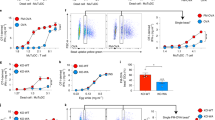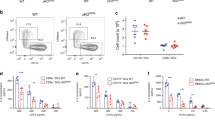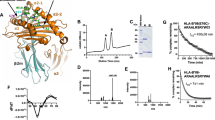Abstract
The involvement of the tetrameric adaptor protein 1 (AP-1) complex in protein sorting in intracellular compartments is not yet completely defined. Here we report that in immature dendritic cells, the β1- and γ-subunits of AP-1 underwent caspase 3–catalyzed cleavage in their hinge regions, resulting in removal of the C-terminal 'ear' domains. Cleavage was inhibited by lipopolysaccharide or caspase inhibitors, each of which led to maturation of the dendritic cells, demonstrated by endosomal remodeling and an increase in surface expression of peptide-loaded major histocompatibility complex class II. Overexpression of similarly truncated AP-1 together with 'silencing' of the endogenous genes in immature dendritic cells did not compromise delivery of major histocompatibility complex class II invariant chain to endosomal compartments. However, after lipopolysaccharide-induced maturation, overexpression of truncated AP-1 and 'silencing' of endogenous genes did result in the anomalous surface accumulation of invariant chain and the peptide-editing molecule H2-DM. Thus, at least one function for intact AP-1 is to retain some proteins in endosomes during the dendritic cell maturation process in which others are allowed to egress to the cell surface.
This is a preview of subscription content, access via your institution
Access options
Subscribe to this journal
Receive 12 print issues and online access
$209.00 per year
only $17.42 per issue
Buy this article
- Purchase on Springer Link
- Instant access to full article PDF
Prices may be subject to local taxes which are calculated during checkout







Similar content being viewed by others
References
Banchereau, J. & Steinman, R.M. Dendritic cells and the control of immunity. Nature 392, 245–252 (1998).
Santambrogio, L., Sato, A.K., Fischer, F.R., Dorf, M.E. & Stern, L.J. Abundant empty class II MHC molecules on the surface of immature dendritic cells. Proc. Natl. Acad. Sci. USA 96, 15050–15055 (1999).
Santambrogio, L. et al. Extracellular antigen processing and presentation by immature dendritic cells. Proc. Natl. Acad. Sci. USA 96, 15056–15061 (1999).
Trombetta, E.S., Ebersold, M., Garrett, W., Pypaert, M. & Mellman, I. Activation of lysosomal function during dendritic cell maturation. Science 299, 1400–1403 (2003).
Kleijmeer, M. et al. Reorganization of multivesicular bodies regulates MHC class II antigen presentation by dendritic cells. J. Cell Biol. 155, 53–63 (2001).
Barois, N., de Saint-Vis, B., Lebecque, S., Geuze, H.J. & Kleijmeer, M.J. MHC class II compartments in human dendritic cells undergo profound structural changes upon activation. Traffic 3, 894–905 (2002).
Chow, A., Toomre, D., Garrett, W. & Mellman, I. Dendritic cell maturation triggers retrograde MHC class II transport from lysosomes to the plasma membrane. Nature 418, 988–994 (2002).
Boes, M. et al. T-cell engagement of dendritic cells rapidly rearranges MHC class II transport. Nature 418, 983–988 (2002).
Villadangos, J.A. et al. MHC class II expression is regulated in dendritic cells independently of invariant chain degradation. Immunity 14, 739–749 (2001).
Inaba, K. et al. The formation of immunogenic major histocompatibility complex class II-peptide ligands in lysosomal compartments of dendritic cells is regulated by inflammatory stimuli. J. Exp. Med. 191, 927–936 (2000).
Barton, G.M. & Rudensky, A.Y. An altered invariant chain protein with an antigenic peptide in place of CLIP forms SDS-stable complexes with class II alphabeta dimers and facilitates highly efficient peptide loading. Int. Immunol. 10, 1159–1165 (1998).
Traub, L.M., Kornfeld, S. & Ungewickell, E. Different domains of the AP-1 adaptor complex are required for Golgi membrane binding and clathrin recruitment. J. Biol. Chem. 270, 4933–4942 (1995).
Traub, L.M., Downs, M.A., Westrich, J.L. & Fremont, D.H. Crystal structure of the alpha appendage of AP-2 reveals a recruitment platform for clathrin-coat assembly. Proc. Natl. Acad. Sci. USA 96, 8907–8912 (1999).
Bonifacino, J.S. & Traub, L.M. Signals for sorting of transmembrane proteins to endosomes and lysosomes. Annu. Rev. Biochem. 72, 395–447 (2003).
Doray, B., Ghosh, P., Griffith, J., Geuze, H.J. & Kornfeld, S. Cooperation of GGAs and AP-1 in packaging MPRs at the trans-Golgi network. Science 297, 1700–1703 (2002).
Hofmann, M.W. et al. The leucine-based sorting motifs in the cytoplasmic domain of the invariant chain are recognized by the clathrin adaptors AP1 and AP2 and their medium chains. J. Biol. Chem. 274, 36153–36158 (1999).
Kongsvik, T.L., Honing, S., Bakke, O. & Rodionov, D.G. Mechanism of interaction between leucine-based sorting signals from the invariant chain and clathrin-associated adaptor protein complexes AP1 and AP2. J. Biol. Chem. 277, 16484–16488 (2002).
Brachet, V., Pehau-Arnaudet, G., Desaymard, C., Raposo, G. & Amigorena, S. Early endosomes are required for major histocompatiblity complex class II transport to peptide-loading compartments. Mol. Biol. Cell 10, 2891–2904 (1999).
Glickman, J.N., Morton, P.A., Slot, J.W., Kornfeld, S. & Geuze, H. The biogenesis of the MHC class II compartment in human I-cell disease B lymphoblasts. J. Cell Biol. 132, 769–785 (1996).
Wong, S.H., Santambrogio, L. & Strominger, J.L. Caspases and nitric oxide broadly regulate dendritic cell maturation and surface expression of class II MHC proteins. Proc. Natl. Acad. Sci. USA 101, 17783–17788 (2004).
Dranoff, G. et al. Vaccination with irradiated tumor cells engineered to secrete murine granulocyte-macrophage colony-stimulating factor stimulates potent, specific, and long-lasting anti-tumor immunity. Proc. Natl. Acad. Sci. USA 90, 3539–3543 (1993).
Winzler, C. et al. Maturation stages of mouse dendritic cells in growth factor-dependent long-term cultures. J. Exp. Med. 185, 317–328 (1997).
Rossig, L. et al. Nitric oxide inhibits caspase-3 by S-nitrosylation in vivo. J. Biol. Chem. 274, 6823–6826 (1999).
Bogdan, C. Nitric oxide and the immune response. Nat. Immunol. 2, 907–916 (2001).
Li, J., Billiar, T.R., Talanian, R.V. & Kim, Y.M. Nitric oxide reversibly inhibits seven members of the caspase family via S-nitrosylation. Biochem. Biophys. Res. Commun. 240, 419–424 (1997).
Woo, M. et al. Caspase-3 regulates cell cycle in B cells: a consequence of substrate specificity. Nat. Immunol. 4, 1016–1022 (2003).
Nogi, T. et al. Structural basis for the accessory protein recruitment by the gamma-adaptin ear domain. Nat. Struct. Biol. 9, 527–531 (2002).
Duncan, M.C., Costaguta, G. & Payne, G.S. Yeast epsin-related proteins required for Golgi-endosome traffic define a γ-adaptin ear-binding motif. Nat. Cell Biol. 5, 77–81 (2003).
Mills, I.G. et al. EpsinR: an AP1/clathrin interacting protein involved in vesicle trafficking. J. Cell Biol. 160, 213–222 (2003).
Bremnes, T., Lauvrak, V., Lindqvist, B. & Bakke, O. A region from the medium chain adaptor subunit (mu) recognizes leucine- and tyrosine-based sorting signals. J. Biol. Chem. 273, 8638–8645 (1998).
Kang, S., Liang, L., Parker, C.D. & Collawn, J.F. Structural requirements for major histocompatibility complex class II invariant chain endocytosis and lysosomal targeting. J. Biol. Chem. 273, 20644–20652 (1998).
Nordeng, T.W. et al. The cytoplasmic tail of invariant chain regulates endosome fusion and morphology. Mol. Biol. Cell 13, 1846–1856 (2002).
Robinson, M.S. & Bonifacino, J.S. Adaptor-related proteins. Curr. Opin. Cell Biol. 13, 444–453 (2001).
Hirst, J., Motley, A., Harasaki, K., Peak Chew, S.Y. & Robinson, M.S. EpsinR: an ENTH domain-containing protein that interacts with AP-1. Mol. Biol. Cell 14, 625–641 (2003).
Mayhew, T.M., Griffiths, G. & Lucocq, J.M. Applications of an efficient method for comparing immunogold labelling patterns in the same sets of compartments in different groups of cells. Histochem. Cell Biol. 122, 171–177 (2004).
Wilhelm, S., Wagner, H. & Hacker, G. Activation of caspase-3-like enzymes in non-apoptotic T cells. Eur. J. Immunol. 28, 891–900 (1998).
Alam, A., Cohen, L.Y., Aouad, S. & Sekaly, R.P. Early activation of caspases during T lymphocyte stimulation results in selective substrate cleavage in nonapoptotic cells. J. Exp. Med. 190, 1879–1890 (1999).
Mukerjee, N., McGinnis, K.M., Gnegy, M.E. & Wang, K.K. Caspase-mediated calcineurin activation contributes to IL-2 release during T cell activation. Biochem. Biophys. Res. Commun. 285, 1192–1199 (2001).
Zermati, Y. et al. Caspase activation is required for terminal erythroid differentiation. J. Exp. Med. 193, 247–254 (2001).
Kolbus, A. et al. Raf-1 antagonizes erythroid differentiation by restraining caspase activation. J. Exp. Med. 196, 1347–1353 (2002).
Moretti, A. et al. Essential myosin light chain as a target for caspase-3 in failing myocardium. Proc. Natl. Acad. Sci. USA 99, 11860–11865 (2002).
Newton, K. & Strasser, A. Caspases signal not only apoptosis but also antigen-induced activation in cells of the immune system. Genes Dev. 17, 819–825 (2003).
Page, L.J., Sowerby, P.J., Lui, W.W. & Robinson, M.S. γ-synergin: an EH domain-containing protein that interacts with γ-adaptin. J. Cell Biol. 146, 993–1004 (1999).
Hirst, J. et al. A family of proteins with γ-adaptin and VHS domains that facilitate trafficking between the trans-Golgi network and the vacuole/lysosome. J. Cell Biol. 149, 67–80 (2000).
Salamero, J., Le Borgne, R., Saudrais, C., Goud, B. & Hoflack, B. Expression of major histocompatibility complex class II molecules in HeLa cells promotes the recruitment of AP-1 Golgi-specific assembly proteins on Golgi membranes. J. Biol. Chem. 271, 30318–30321 (1996).
Mallard, F. et al. Direct pathway from early/recycling endosomes to the Golgi apparatus revealed through the study of shiga toxin B-fragment transport. J. Cell Biol. 143, 973–990 (1998).
Meyer, C. μ1A-adaptin-deficient mice: lethality, loss of AP-1 binding and rerouting of mannose 6-phosphate receptors. EMBO J. 19, 2193–2203 (2000).
Waguri, S. et al. Visualization of TGN to endosome trafficking through fluorescently labeled MPR and AP-1 in living cells. Mol. Biol. Cell 14, 142–155 (2003).
Corradin, S.B., Mauel, J., Donini, S.D., Quattrocchi, E. & Ricciardi-Castagnoli, P. Inducible nitric oxide synthase activity of cloned murine microglial cells. Glia 7, 255–262 (1993).
Raposo, G. & Kleijmeer, M.J. in Handbook of Experimental Immunology 5th edn. Ch. 208 (ed. Herzenberg, L.W., Herzenberg, L.A. and Blackwell, C.) 1–11 (I. Blackwell Science, Cambridge, Massachusetts, 1997).
Villadangos, J.A. et al. Proteases involved in MHC class II antigen presentation. Immunol. Rev. 172, 109–120 (1999).
Acknowledgements
We thank M.-L. Wong for assistance; J. Bonifacino for reviewing and criticizing the manuscript; and T.W. Mak for providing caspase 3–deficient mice. Supported by National Institutes of Health (AI49524 to J.L.S. and AI48832 to L.S.) and Irene Diamond Professorships in Immunology (L.S.).
Author information
Authors and Affiliations
Corresponding authors
Ethics declarations
Competing interests
The authors declare no competing financial interests.
Supplementary information
Supplementary Fig. 1
Analysis of AP-1 caspase 3 cleavage sites and caspase 3 activity in immature BMDC. (PDF 630 kb)
Supplementary Fig. 2
μ1 siRNA enhances surface Ii expression. (PDF 192 kb)
Supplementary Fig. 3
Decreased AP-1 and vesicle localization at the TGN in LPS and CI treated cells. (PDF 303 kb)
Supplementary Fig. 4
Diagram of the truncated AP-1 complex utilized in the transfection experiment reported in Figure 7. (PDF 104 kb)
Supplementary Fig. 5
Redistribution of endosome-associated AP-1 during DC maturation. (PDF 1447 kb)
Rights and permissions
About this article
Cite this article
Santambrogio, L., Potolicchio, I., Fessler, S. et al. Involvement of caspase-cleaved and intact adaptor protein 1 complex in endosomal remodeling in maturing dendritic cells. Nat Immunol 6, 1020–1028 (2005). https://doi.org/10.1038/ni1250
Received:
Accepted:
Published:
Issue Date:
DOI: https://doi.org/10.1038/ni1250
This article is cited by
-
Glycolysis promotes caspase-3 activation in lipid rafts in T cells
Cell Death & Disease (2018)
-
Heterodimer HLA-DM Fused with Constant Fragment of the Heavy Chain of the Human Immunoglobulin Accelerates Influenza Hemagglutinin HA306–318 Loading to HLA-DR1
Bulletin of Experimental Biology and Medicine (2016)
-
Towards a systems understanding of MHC class I and MHC class II antigen presentation
Nature Reviews Immunology (2011)
-
Multiple-labelling immunoEM using different sizes of colloidal gold: alternative approaches to test for differential distribution and colocalization in subcellular structures
Histochemistry and Cell Biology (2011)
-
A novel CARD containing splice-isoform of CIITA regulates nitric oxide synthesis in dendritic cells
Protein & Cell (2010)



